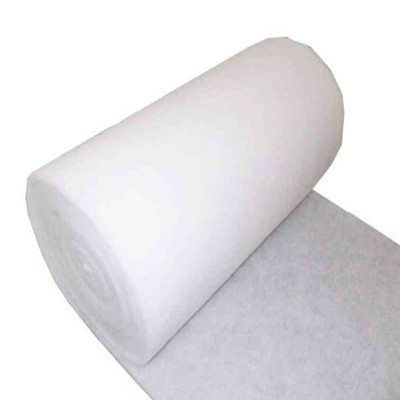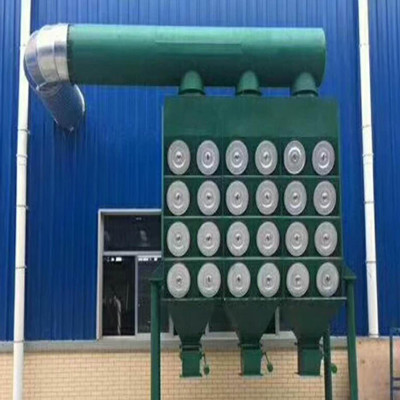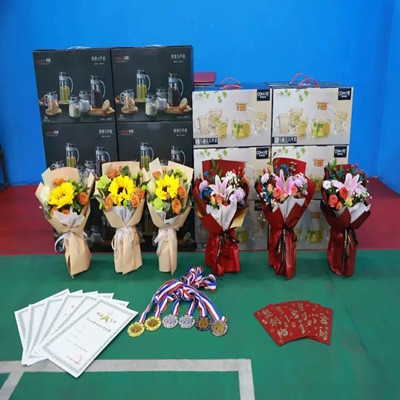Filter cotton
Material:Special materialsFilter Type:
Car Fitment: /
Size: Standard
Color Customers\' Require
Package: Customized/Neutral
Filtration Efficiency: G1,G2,G3,G4,F5,F6,F7,F8
Sample: Avialable/Free
Place of Origin: CHINA
Filter cotton
The range of filter cotton is relatively wide, and the filter cotton (filter mesh) usually referred to generally refers to air filtration. Filter cotton is divided into four types according to different materials: synthetic fiber filter cotton, non-woven filter cotton, glass fiber filter cotton, activated carbon filter cotton.
Filter cotton can also be divided into different filter efficiency: primary filter cotton, medium-efficiency filter cotton.
Quick Details
Material:Synthetic fiber filter cotton,Non-woven filter cotton,Glass fiber filter cotton,Activated carbon filter cotton.
Filter Type: Air Filter
Size: Standard
Color Customers\' Require
Package: Customized/Neutral
Filtration Efficiency: G1,G2,G3,G4,F5,F6,F7,F8
Sample: Avialable/Free
Place of Origin: CHINA
Application
Many industrial productions must be carried out in a relatively clean space, such as surface treatment, paint coating, spraying, precision electronics, optical electronics, biopharmaceuticals, food production, air cooling, etc. These environments require flowing air, but no dust. Therefore, it is necessary to filter out the dust with filter cotton, and only allow clean air to circulate in a relatively closed space, so as to meet the needs of production and operation.
Material of Filter cotton
1. Synthetic fiber filter cotton:
It can fully replace the full range of non-woven fabrics and glass fiber covering coarse, medium and high-efficiency filtration products under the general filtration environment. It is an emerging filter material and the main development direction of future filter materials. Compared with other filter materials of the same level, it has the advantages of low resistance, light weight, large capacity, environmental protection (can be incinerated), and moderate price. It uses (polyester fibre) as the main raw material, abbreviated as PET. Polyester fibre is made of polyethylene terephthalate, also known as synthetic fibre or polyester. The specific gravity of the polyester fiber is 1.38; the melting point is 255~260℃, and it starts to bond at 205℃, and the safe ironing temperature is 135℃; the water absorption is poor, only 0.4%; the breaking strength of the filament is 4.5~5.5 g/denier , Short fiber is 3.5~5.5g/denier; the elongation at break of filament is 15~25%, short fiber is 25~40%; the strength of high-strength fiber can reach 7~8g/den, and the elongation is 7.5~ 12.5%. Polyester has excellent wrinkle resistance, elasticity and dimensional stability, good electrical insulation properties, resistance to sunlight, abrasion, mildew and moth, good resistance to chemical reagents, and resistance to weak acids and alkalis. The industry name is: chemical fiber. Chemical fiber is divided into large chemical fiber and small chemical fiber. Large chemical fiber refers to polyester fiber produced from high-quality PET chips. Small chemical fiber refers to the fiber produced by some small and medium-sized manufacturers using poor quality recycled materials to regenerate PET chips.
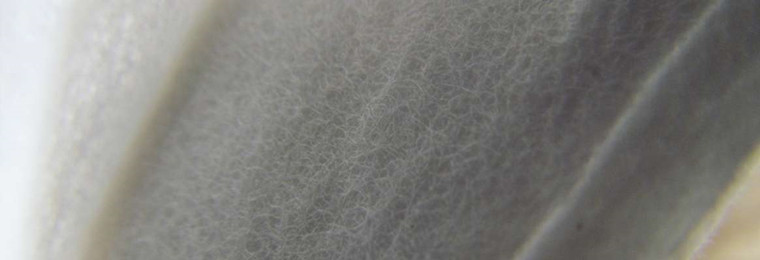
2. Non-woven filter cotton:
The scientific name is polyester fiber, commonly known as non-woven fabric. Non-woven fabric has technical characteristics such as wide use, technical maturity, and good stability. It is a typical filter material for my country's primary and medium-efficiency plate and bag filters. The manufacturing process is made by melt-blown, needle punch, spunlace, spunbond and other processes through multiple processes. Compared with other filters of the same level, it has stable quality, larger dust holding capacity, strong moisture resistance, long service life, and economical Durable and other advantages. Non-woven fabric is also the earliest application of filter material. The technology is mature and the production cost is low. In recent years, due to the continuous progress of technology, the emergence of composite non-woven fabric has greatly improved the image of non-woven fabrics of low-cost and low-end. Efficient. At the same time, the composite non-woven filter material can also be used for filtering in places where air cleanliness is relatively high.
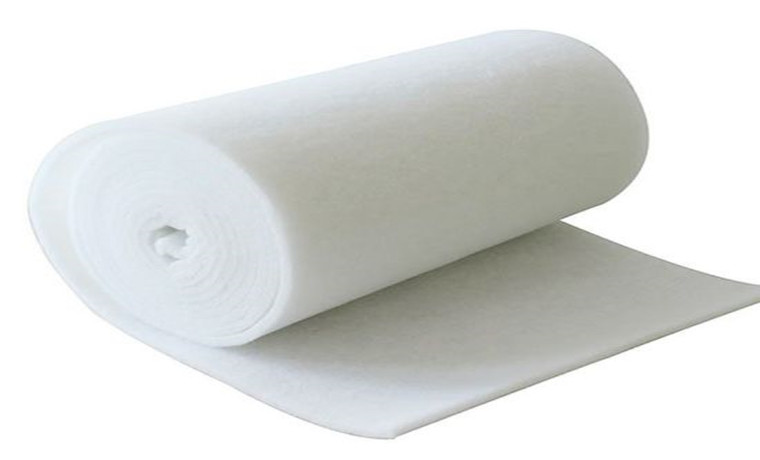
3. Glass fiber filter cotton:
Glass fiber filter cotton is mainly made of glass fibers of various thicknesses and lengths through special processing techniques. Glass fiber is characterized by its stable performance, high temperature resistance, high efficiency, large capacity, and long service life. And in some special environments, only glass fiber can do the job. It is widely used in primary effect filters, high temperature resistant filters and high efficiency filters of general ventilation systems, and in places and environments that require high air filtration.
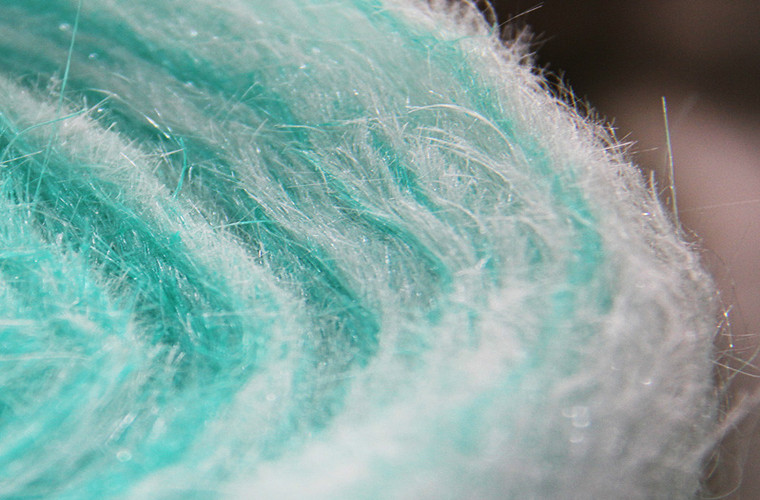
4. Activated carbon filter cotton:
The characteristic of activated carbon is to remove the peculiar smell in the air. Activated carbon filter cotton refers to synthetic fibers that have been soaked in carbon and treated with glue. Because the role of activated carbon is to remove odors, the filtration efficiency is not emphasized. In use. Generally, it must be used with independent primary and middle-efficiency filters.
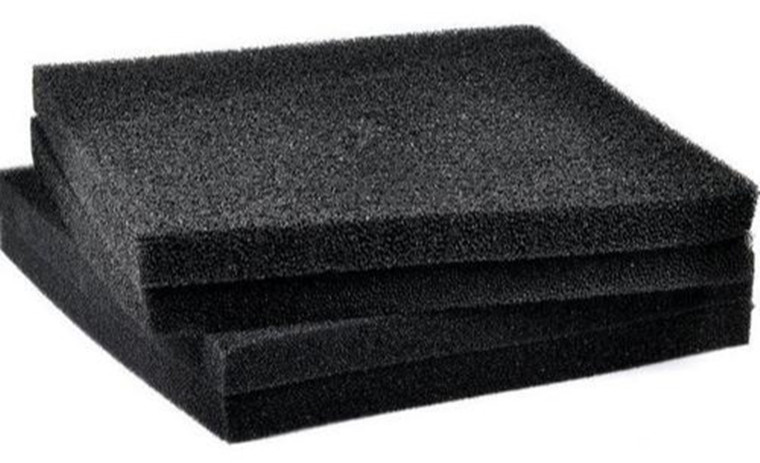
Performance of Filter cotton
1. 100% relative humidity resistance;
2. Meet the European fire classification standards;
3. Application: assembly workshop, spray paint and baking workshop, surface refurbishment, baking paint room, etc.
Filter cotton products are generally used in the surface coating industry. They are specially designed for filtering at the end of the spray booth. They are made of high-performance hot-melt non-woven fabrics composed of anti-fracture synthetic fibers. They adopt an incremental structure, which is toward the direction of pure air. The fiber density gradually increases, the filtration efficiency also increases, and the service life is longer.
Production Process
After opening, mixing and carding, it is evenly formed into a net and then heated and cooled to form a sheet or roll. After finishing (such as gluing, bonding with cloth (net), etc.), the air filter cotton is finally dried and shaped, also called hot air cotton. It can resist the influence of chemical substances such as chemical solvents and acidic fumes; incremental structure, using gradual density multi-layer technology, can be blocked at different density levels according to the size of the dust, and more effectively accommodate more dust; with dust holding With the characteristics of high volume and low resistance, it can be used multiple times after vacuuming or cleaning.
Process flow
Blending-Opening-Secondary Opening-Blending Box-Carding-Laying-Hot Air Setting-Cooling-Edge Curling
1. Cotton blending: According to the different requirements of customers, the fiber cotton is proportioned according to different proportions. After weighing the initial weight, it is poured into the mixer and the machine rotates and stirs. The purpose is to mix all kinds of raw materials evenly.
2. Opening: The stirred agglomerates of fibers are transferred to the licker roller device through the rollers, and then they are sent in sequence. After the fiber agglomerations are opened strongly, they are then sent to the second opening by the fan. Sending device. The fiber mass is sent to the mixing box by the fan after being sent twice, and mixed by the vibration of the wool bucket.
3. Carding: The cotton layer with uniform thickness and uniform distribution is transferred to the upper screen by the cylinder and doffer carding workers, and then spread into a net by shaking the screen.
4. Laying the net: Swing back and forth by shaking the screen, spread it into a uniform net layer and then send it into the oven from the bottom screen.
5. Hot air shaping: send a uniform layer of cotton into the oven, and the low-melting fiber in the oven at a certain temperature will hold various fibers together to form synthetic fiber cotton.
6. Cold-air setting, trimming and crimping: After the cold-air setting, synthetic fiber cotton is passed through the pressing shaft to determine the thickness, and then the trimming of the specified value, when the length reaches the specified value, it is cut by the thermal fuse and then rolled.
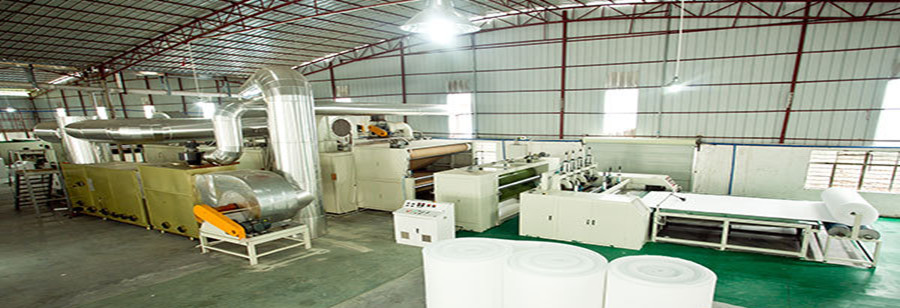
Filtration Efficiency:
According to the national standard (GB/T14295), it can be divided into: coarse (initial) efficiency, medium efficiency, high efficiency,
According to the European standard, it can be divided into: G1, G2, G3, G4, F5, F6, F7, F8 coarse (primary) efficiency filter cotton (air outlet cotton)
Mainly filter dust particles larger than 5μm, generally used in ventilation equipment and air control system suction port as a pre-filter or coarse filter where it is directly in contact with outdoor air; it is also mostly used in plate filters, folding plate filters, and bag filters Filter materials such as filter equipment.
Primary-efficiency filter cotton: It can also be used as pre-filtering under high dust exposure in the air supply system; pre-filtering and flow-sharing filter material and characteristics of the air supply in the spraying system and the baking device.
Medium-efficiency filter cotton (canopy cotton): mainly filter dust particles larger than 1μm, generally used for secondary or final filtration after coarse-efficiency filtration, and also mostly used as filter material for plate filters.
High-efficiency filter cotton: Mainly used in hospitals or laboratories where filtration requirements are particularly high.
Knowledge expansion
As we all know, the air contains a lot of dust particles (such as dust, dust, smoke, mineral dust, sand dust, powder, etc.), because these dust particles are very light, so when the flowing air acts on these dust particles, the dust will be removed. The weight of the particles is offset and the dust is in a floating state. Only in a relatively closed space and the air is relatively static, the dust will fall to the ground under the action of the earth's gravity. This is why the doors and windows are closed in the room. In the absence of a place to live, a thick layer of dust will be seen on the furniture and the ground after a period of time. The amount of dust in the air is related to many objective factors, such as weather conditions, seasonal changes, industrial production, mineral mining, land desertification, soil erosion, environmental pollution, etc. Dust has an impact on the human body, on production, on product quality, on the environment, on the beauty of natural scenery, and on ecological balance.
An adult needs about 19m3 of air every day to get the required oxygen from it. If the air at the worker’s workplace contains a lot of dust, people working in this environment will inhale more dust into the lungs. Many harmful gases, liquids or certain metal elements can be adsorbed on it. When it is taken into the lungs or adhered to the wall of the bronchus, it causes or aggravates various diseases of the respiratory organs. When a certain amount is reached, it can cause fibrotic lesions in the lung tissues and gradually make the lung tissues Hardening, loss of normal respiratory function, causing related diseases, so why wear a mask in an environment with poor air index can effectively prevent the occurrence of diseases, because a mask is a kind of filter cotton, which can effectively filter out dust in the air Particles, thereby ensuring the cleanliness of the inhaled air.
The dust in the air falling on the rotating parts of the machine will accelerate the wear of the rotating parts and reduce the accuracy and life of the machine. Dust in the workshop can also reduce visibility, affect vision, hinder operation, reduce labor productivity, and even cause accidents. Dust discharged into the atmosphere will cause atmospheric pollution. In addition, the dust in the air will reduce the visibility of the atmosphere, promote the formation of smog, and affect the transmission of solar radiation energy.
In summary, filter cotton has its indispensable position, because many industrial production must be carried out in a relatively clean space, such as surface treatment, paint coating, spraying, precision electronics, optical electronics, biopharmaceuticals, food Production, air cooling, etc., these environments require flowing air, but no dust, so filter cotton is needed to filter out the dust, and only clean air is circulated in a relatively closed space, so as to meet the needs of production and operation
The range of filter cotton is relatively wide, and the filter cotton (filter mesh) usually referred to generally refers to air filtration. Filter cotton is divided into four types according to different materials: synthetic fiber filter cotton, non-woven filter cotton, glass fiber filter cotton, activated carbon filter cotton.
Filter cotton can also be divided into different filter efficiency: primary filter cotton, medium-efficiency filter cotton.
Quick Details
Material:Synthetic fiber filter cotton,Non-woven filter cotton,Glass fiber filter cotton,Activated carbon filter cotton.
Filter Type: Air Filter
Size: Standard
Color Customers\' Require
Package: Customized/Neutral
Filtration Efficiency: G1,G2,G3,G4,F5,F6,F7,F8
Sample: Avialable/Free
Place of Origin: CHINA
Application
Many industrial productions must be carried out in a relatively clean space, such as surface treatment, paint coating, spraying, precision electronics, optical electronics, biopharmaceuticals, food production, air cooling, etc. These environments require flowing air, but no dust. Therefore, it is necessary to filter out the dust with filter cotton, and only allow clean air to circulate in a relatively closed space, so as to meet the needs of production and operation.
Material of Filter cotton
1. Synthetic fiber filter cotton:
It can fully replace the full range of non-woven fabrics and glass fiber covering coarse, medium and high-efficiency filtration products under the general filtration environment. It is an emerging filter material and the main development direction of future filter materials. Compared with other filter materials of the same level, it has the advantages of low resistance, light weight, large capacity, environmental protection (can be incinerated), and moderate price. It uses (polyester fibre) as the main raw material, abbreviated as PET. Polyester fibre is made of polyethylene terephthalate, also known as synthetic fibre or polyester. The specific gravity of the polyester fiber is 1.38; the melting point is 255~260℃, and it starts to bond at 205℃, and the safe ironing temperature is 135℃; the water absorption is poor, only 0.4%; the breaking strength of the filament is 4.5~5.5 g/denier , Short fiber is 3.5~5.5g/denier; the elongation at break of filament is 15~25%, short fiber is 25~40%; the strength of high-strength fiber can reach 7~8g/den, and the elongation is 7.5~ 12.5%. Polyester has excellent wrinkle resistance, elasticity and dimensional stability, good electrical insulation properties, resistance to sunlight, abrasion, mildew and moth, good resistance to chemical reagents, and resistance to weak acids and alkalis. The industry name is: chemical fiber. Chemical fiber is divided into large chemical fiber and small chemical fiber. Large chemical fiber refers to polyester fiber produced from high-quality PET chips. Small chemical fiber refers to the fiber produced by some small and medium-sized manufacturers using poor quality recycled materials to regenerate PET chips.

2. Non-woven filter cotton:
The scientific name is polyester fiber, commonly known as non-woven fabric. Non-woven fabric has technical characteristics such as wide use, technical maturity, and good stability. It is a typical filter material for my country's primary and medium-efficiency plate and bag filters. The manufacturing process is made by melt-blown, needle punch, spunlace, spunbond and other processes through multiple processes. Compared with other filters of the same level, it has stable quality, larger dust holding capacity, strong moisture resistance, long service life, and economical Durable and other advantages. Non-woven fabric is also the earliest application of filter material. The technology is mature and the production cost is low. In recent years, due to the continuous progress of technology, the emergence of composite non-woven fabric has greatly improved the image of non-woven fabrics of low-cost and low-end. Efficient. At the same time, the composite non-woven filter material can also be used for filtering in places where air cleanliness is relatively high.

3. Glass fiber filter cotton:
Glass fiber filter cotton is mainly made of glass fibers of various thicknesses and lengths through special processing techniques. Glass fiber is characterized by its stable performance, high temperature resistance, high efficiency, large capacity, and long service life. And in some special environments, only glass fiber can do the job. It is widely used in primary effect filters, high temperature resistant filters and high efficiency filters of general ventilation systems, and in places and environments that require high air filtration.

4. Activated carbon filter cotton:
The characteristic of activated carbon is to remove the peculiar smell in the air. Activated carbon filter cotton refers to synthetic fibers that have been soaked in carbon and treated with glue. Because the role of activated carbon is to remove odors, the filtration efficiency is not emphasized. In use. Generally, it must be used with independent primary and middle-efficiency filters.

Performance of Filter cotton
1. 100% relative humidity resistance;
2. Meet the European fire classification standards;
3. Application: assembly workshop, spray paint and baking workshop, surface refurbishment, baking paint room, etc.
Filter cotton products are generally used in the surface coating industry. They are specially designed for filtering at the end of the spray booth. They are made of high-performance hot-melt non-woven fabrics composed of anti-fracture synthetic fibers. They adopt an incremental structure, which is toward the direction of pure air. The fiber density gradually increases, the filtration efficiency also increases, and the service life is longer.
Production Process
After opening, mixing and carding, it is evenly formed into a net and then heated and cooled to form a sheet or roll. After finishing (such as gluing, bonding with cloth (net), etc.), the air filter cotton is finally dried and shaped, also called hot air cotton. It can resist the influence of chemical substances such as chemical solvents and acidic fumes; incremental structure, using gradual density multi-layer technology, can be blocked at different density levels according to the size of the dust, and more effectively accommodate more dust; with dust holding With the characteristics of high volume and low resistance, it can be used multiple times after vacuuming or cleaning.
Process flow
Blending-Opening-Secondary Opening-Blending Box-Carding-Laying-Hot Air Setting-Cooling-Edge Curling
1. Cotton blending: According to the different requirements of customers, the fiber cotton is proportioned according to different proportions. After weighing the initial weight, it is poured into the mixer and the machine rotates and stirs. The purpose is to mix all kinds of raw materials evenly.
2. Opening: The stirred agglomerates of fibers are transferred to the licker roller device through the rollers, and then they are sent in sequence. After the fiber agglomerations are opened strongly, they are then sent to the second opening by the fan. Sending device. The fiber mass is sent to the mixing box by the fan after being sent twice, and mixed by the vibration of the wool bucket.
3. Carding: The cotton layer with uniform thickness and uniform distribution is transferred to the upper screen by the cylinder and doffer carding workers, and then spread into a net by shaking the screen.
4. Laying the net: Swing back and forth by shaking the screen, spread it into a uniform net layer and then send it into the oven from the bottom screen.
5. Hot air shaping: send a uniform layer of cotton into the oven, and the low-melting fiber in the oven at a certain temperature will hold various fibers together to form synthetic fiber cotton.
6. Cold-air setting, trimming and crimping: After the cold-air setting, synthetic fiber cotton is passed through the pressing shaft to determine the thickness, and then the trimming of the specified value, when the length reaches the specified value, it is cut by the thermal fuse and then rolled.

Filtration Efficiency:
According to the national standard (GB/T14295), it can be divided into: coarse (initial) efficiency, medium efficiency, high efficiency,
According to the European standard, it can be divided into: G1, G2, G3, G4, F5, F6, F7, F8 coarse (primary) efficiency filter cotton (air outlet cotton)
Mainly filter dust particles larger than 5μm, generally used in ventilation equipment and air control system suction port as a pre-filter or coarse filter where it is directly in contact with outdoor air; it is also mostly used in plate filters, folding plate filters, and bag filters Filter materials such as filter equipment.
Primary-efficiency filter cotton: It can also be used as pre-filtering under high dust exposure in the air supply system; pre-filtering and flow-sharing filter material and characteristics of the air supply in the spraying system and the baking device.
Medium-efficiency filter cotton (canopy cotton): mainly filter dust particles larger than 1μm, generally used for secondary or final filtration after coarse-efficiency filtration, and also mostly used as filter material for plate filters.
High-efficiency filter cotton: Mainly used in hospitals or laboratories where filtration requirements are particularly high.
Knowledge expansion
As we all know, the air contains a lot of dust particles (such as dust, dust, smoke, mineral dust, sand dust, powder, etc.), because these dust particles are very light, so when the flowing air acts on these dust particles, the dust will be removed. The weight of the particles is offset and the dust is in a floating state. Only in a relatively closed space and the air is relatively static, the dust will fall to the ground under the action of the earth's gravity. This is why the doors and windows are closed in the room. In the absence of a place to live, a thick layer of dust will be seen on the furniture and the ground after a period of time. The amount of dust in the air is related to many objective factors, such as weather conditions, seasonal changes, industrial production, mineral mining, land desertification, soil erosion, environmental pollution, etc. Dust has an impact on the human body, on production, on product quality, on the environment, on the beauty of natural scenery, and on ecological balance.
An adult needs about 19m3 of air every day to get the required oxygen from it. If the air at the worker’s workplace contains a lot of dust, people working in this environment will inhale more dust into the lungs. Many harmful gases, liquids or certain metal elements can be adsorbed on it. When it is taken into the lungs or adhered to the wall of the bronchus, it causes or aggravates various diseases of the respiratory organs. When a certain amount is reached, it can cause fibrotic lesions in the lung tissues and gradually make the lung tissues Hardening, loss of normal respiratory function, causing related diseases, so why wear a mask in an environment with poor air index can effectively prevent the occurrence of diseases, because a mask is a kind of filter cotton, which can effectively filter out dust in the air Particles, thereby ensuring the cleanliness of the inhaled air.
The dust in the air falling on the rotating parts of the machine will accelerate the wear of the rotating parts and reduce the accuracy and life of the machine. Dust in the workshop can also reduce visibility, affect vision, hinder operation, reduce labor productivity, and even cause accidents. Dust discharged into the atmosphere will cause atmospheric pollution. In addition, the dust in the air will reduce the visibility of the atmosphere, promote the formation of smog, and affect the transmission of solar radiation energy.
In summary, filter cotton has its indispensable position, because many industrial production must be carried out in a relatively clean space, such as surface treatment, paint coating, spraying, precision electronics, optical electronics, biopharmaceuticals, food Production, air cooling, etc., these environments require flowing air, but no dust, so filter cotton is needed to filter out the dust, and only clean air is circulated in a relatively closed space, so as to meet the needs of production and operation
Please Feel free to give your inquiry in the form below.We will reply you in 24 hours.


